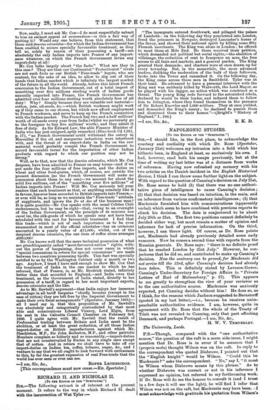[To TILE Esrroa or THE "SPECTATOR. "] SIR, — The following extract is
of interest at the present moment. It refers to the way in which Richard II. dealt with the insurrection of Wat Tyler "The insurgents entered Southwark, and pillaged the palace of Lambeth : on the following day they penetrated into London, freed the prisoners in Newgate, destroyed Lancaster's house of the Savoy, and showed their national spirit by killing some fifty Flemish merchants. The King was alone in London : he offered to meet them at Mile End. He there received their petition, which demanded not political but social rights,—the abolition of villeinage, the reduction of rent to fourpenco an acre, the free access to all fairs and markets, and a general pardon. The King granted their demands ; and charters were at once drawn up for every township. But, in the meanwhile, the more advanced leaders, disliking the moderation of the bulk of their followers, broke into the Tower and ransacked it. On the following day, the King came across these men in Smithfield. Tyler was at their head. He advanced to have a personal interview with the King and was suddenly killed by Walworth, the Lord Mayor, as he played with his dagger, an action which was construed as a threat. The yourg King rode forward to the astonished rebels, declared he would be their leader, and induced them to follow him to Islington, where they found themselves in the presence of Sir Robert Knowles and 1,000 soldiers. They at once yielded, and demanded the King's mercy ; he declined to punish them and dismissed them to their homes."—(Bright's " History of England," I., 244.)






















































 Previous page
Previous page